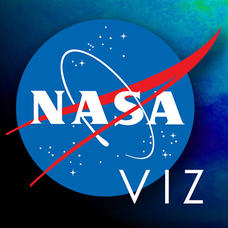Read some of the most up-to-date information available from NASA's current Earth and space research! Along with showcased stories, you will find computer animations and satellite images that help you to view what humans cannot see with their own eyes.
Concepts
Additional Tags
App Overview
Features:
- Over 200 stories, with two more automatically added weekly
- Amazing computer-generated animations
- Stunning satellite imagery
- Narrated educational video clips
- Ability to bookmark favorite stories, save off-line, or organize into customized lists
- Share stories with friends
Using NASA Visualization Explorer:
- Upon the first opening, a welcome screen introduces you to the app and leads you to view instructions (Otherwise, it opens where you left it)
- Swipe or tap to read consecutive stories
- Tap to show text or media gallery
- Tap thumbnails in the gallery to display actual media
- Press and hold images to share them via social networking websites
Five Buttons in the Lower Right Corner:
- Downward Arrow: Save story off-line
- Star: Add to My Favorites
- Folder with Arrow: Copy or share
- Plus Sign: Add to a customized list
- Information: Credits
Menu Button in Lower Left Corner:
- Lists stories in order of publishing date
- Stories by topic (Earth, Planets and Moons, Sun, and Universe)
- Saved Stories
- My Favorites
There is also a Settings button in upper-right corner where you can choose options, review instructions, or contact the developer.
Curator Rating
-
Adherence to task
Fascinating information, but not necessarily useful in the classroom
-
Worth the money
A free app, so it is worth having on hand
-
Fun factor
Stunning images and current content
-
Scaffolding of learning
Opening screen provides option to view instructions
-
User safety
-
Control and feedback
Save or sort stories
-
How techie do I need to be?
Intermediate
Instructional Ideas
Your earth science or astronomy class will enjoy selecting stories to read. Use the Story Lists and sort by topic to assign explorations related to the topic you are covering in your curriculum.
Display some of the images as an example of remote sensing when introducing a science class to the tools of a scientist.
Classroom Considerations
There is no option to turn off the music that accompanies animations, so you may want to make earbuds available if using it in a center.
When using a tablet, it is not clear where stories are stored off-line. This may only be an option when using NASA Visualization Explorer on a computer.
Pros
- Free
- The most current research information
- Incredible imagery and animations
- Automatic upload of new stories
Cons
- Main menu organized by upload date, not by title
- Limited classroom use


